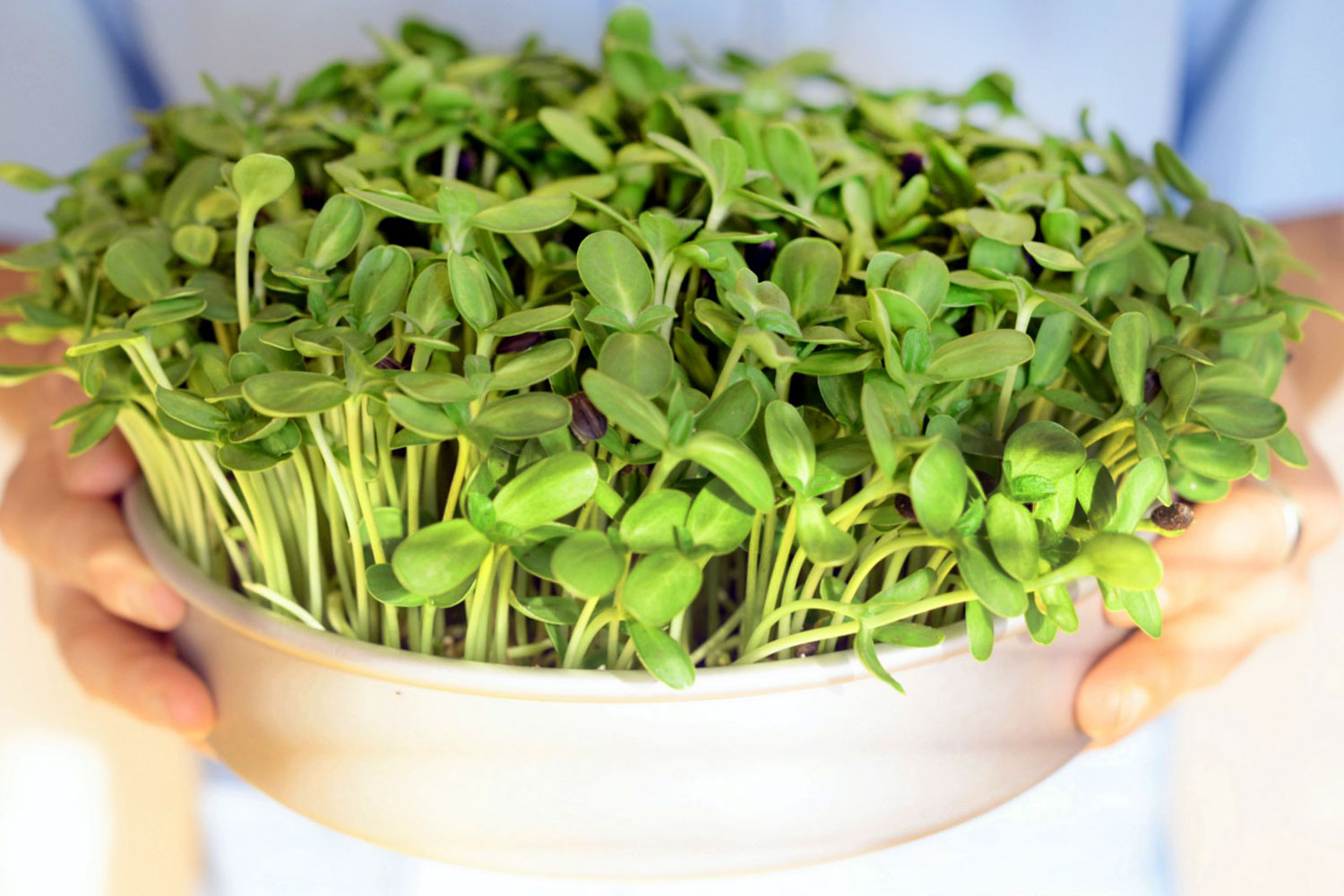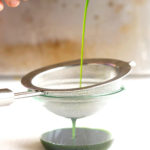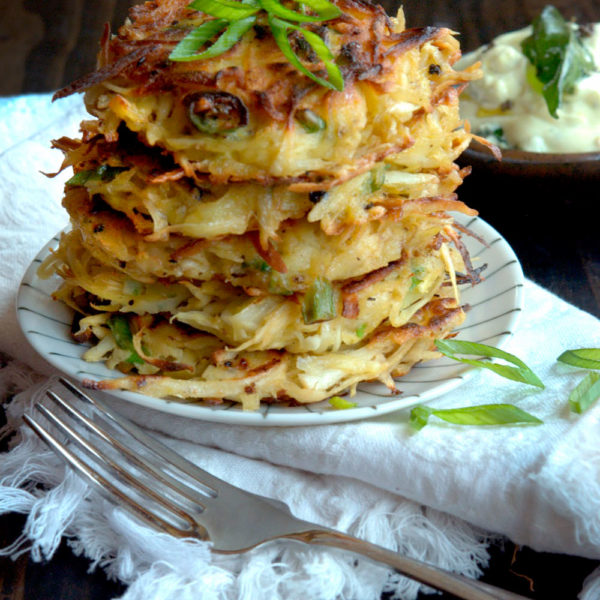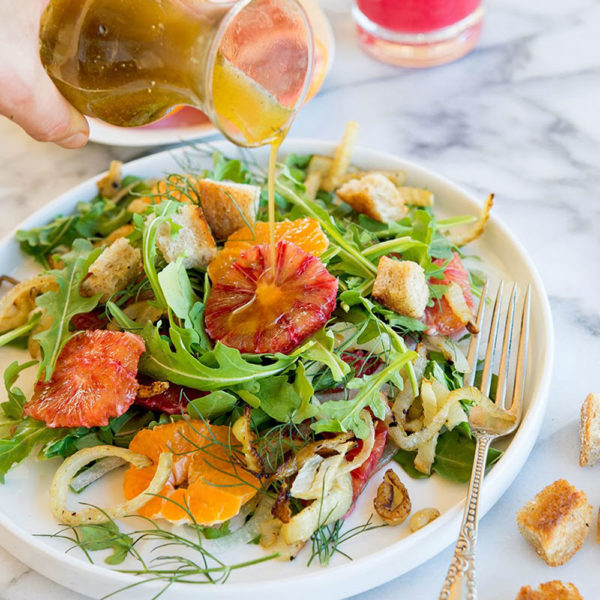The warm summer air has got me yearning to plant, seed, sprout, and grow something. But city dwelling doesn’t always lend itself well to this task. Without outdoor space or even a balcony (and the community garden down the street has a five-year wait list) the options are limited. That just means you need to get extra creative. Fear not, there are plants that you can grow indoors. That leads me to the topic of today’s post — growing your own microgreens — my new edible project. As their name implies, microgreens are small and don’t require much space, which makes them ideally suited for cramped urban living.
A few years back, I took a microgreens workshop with Bill Shores (who manages Chef Rick Bayless’ organic gardens for his restaurants in Chicago). He recommends growing these greens stacked on shelves, under lights (see section below, How to Grow Microgreens, for more info on how to grow under lights). But, I don’t currently have room for such a set up (in my over-priced, under-sized, one bedroom). So, decided to see how they would do if I just put them in front of the window sill (after sprouting; see notes on sprouting below). The only downfall is that my cat also thinks these are a tasty treat and I find him mischievously nibbling on them from time to time.
I first experimented with sunflower seeds and wheat grass (hard winter red wheat) and they did wonderful; wheat grass (which I juiced) is pretty terrible tasting potent and a much acquired taste (no thanks, not for me). But, the sunflower microgreens are delicate in flavor and a great addition to liven up any salad, soup, or sandwich.
Have also been experimenting with onion, beet, broccoli rabe, daikon radish, and arugula (quick update: just started some radish, beet, and onion microgeens a few days ago and they’re quickly popping up). You will be amazed how quickly they grow.
This is also a great project for kids. Something they can nurture and take care of themselves, gaining appreciation for where their food comes from, and tasting the fruit of their labor (with minimal effort).
For today’s salad, I incorporated a mix of sunflower, beet, broccoli rabe, and onion microgreens, along with fresh fava beans, Thai basil, edible flowers (nasturtium), toasted pumpkin seeds, toasted amaranth seeds, and goat cheese. I paired it with a bold honey-lime-ginger dressing, but a simple balsamic-vinaigrette would also be nice.
A word on microgreens…
After a little research, I learned that sprouts and microgreens are not the same. Sprouts are seeds germinated in water just long enough (usually 48 hours) to grow roots, a stem and pale, underdeveloped leaves. Microgreens, on the other hand, need to grow in soil and under direct light before you can harvest them. Microgreens are the first true leaf stage of growth.
An interesting tidbit…
Researchers at the USDA and University of Maryland, College Park (yay, my alma mater) looked at four groups of vitamins and other phytochemicals – including vitamin C, vitamin E, and beta carotene — in 25 varieties of microgreens. They found that leaves from almost all of the microgreens had four to forty times more nutrients than the mature leaves of the same plant. So, they are not only tasty, but highly nutritious as well.
Currently have some onion, beet, and broccoli rabe microgreens sprouting as we speak…now I just need more window space to accommodate my new hobby. If you time it right, you can get a system down, where you have a wide variety of microgreens available whenever you want.
These are onion microgreens, they taste, well, like onions…
These are beet microgreens, just like beet roots, they’re a little bit sweet…
A Salad of Homegrown Microgreens
This is what went into the salad; but feel free to add or omit based on your taste:
Mix of microgreens (such as sunflower, radish, broccoli rabe, radish, and/or onion)
Edible flowers
Fresh fava beans (yum, they are tender and sweet when fresh)
Thai basil leaves
Toasted pumpkin seeds
Toasted popped amaranth
Goat cheese
Sea salt and freshly ground black pepper
Lime-Honey-Ginger Dressing
Adjust seasoning to taste, adding more or less honey and spices depending on desired sweetness/heat.
1/4 cup extra virgin olive oil
1 tablespoon fish sauce
drizzle of honey to taste (~1 teaspoon)
2 tablespoons lime juice
1 small clove of garlic, grated
1 teaspoon grated ginger
pinch of cayenne or Asian chile powder (more or less to taste)
few grinds of black pepper
Combine all ingredients in a bowl and whisk.
Growing Microgreens
The steps are the same regardless of the type of microgreen you want to grow. Some seeds, like sunflower, just take a little longer to sprout and grow than others. Take a look at Mumm‘s sprouting seeds or Johnny’s Select Seeds, they have a wide assortment of sprouting seeds.
Supplies :
organic potting soil
trays (any size/type tray will do; I used a couple of baking pans)
organic, untreated seeds (check out Mumm’s Sprouting Seeds and Johnny’s Selected Seeds)
fluorescent lights like this (1 cool, 1 warm); optional
Step 1: For sunflower seeds and wheat grass (hard winter red wheat) — soak the seeds/grain in warm water (~70 degree) for 8 hours or overnight in a glass jar (a glass canning jar with a mesh top works well). Drain well. Place the jar in a warm, dark space, rinsing and draining 2 times a day, until they start to sprout and you see a small white root (this will take a few days). For other seeds, you can skip this step and move on to step 2.
To give you an idea how much sunflower seeds to start with: 1/2 to 3/4 cup for a 9 X 9 tray is plenty.
Step 2: In a bucket, moisten the organic potting soil with water (moist but not soaked). Fill the trays/containers with soil to within 1/2 inch of the top of each container. Level the soil with your hand.
Step 3: Sprinkle the seeds across the entire soil surface. For smaller seeds, like the radish, broccoli rabe, and arugula, you want 1/4 inch spaces between seeds. For larger seeds, like the sunflower, the seeds should be touching, covering the entire surface of the soil. Make sure each seed is in contact with the soil surface (otherwise they will not germinate).
Step 4: Mist the seeds with a spray bottle (which will gently push the seeds into the soil) until the soil surface is damp.
Step 5: Stack the containers on top of each other and place an empty container on top. The stacking keeps the seeds in the dark and in contact with the soil, ideal for germination. Keep the trays in a warm place (ideally between 72-75 degrees) for about 3-5 days. Each day check the moisture, if they are dry, mist with water.
Step 6: After about 3-5 days, as the seedlings start to push up, they are ready to be put under the light. The broccoli rabe, radish, and arugula will be ready to be put under the light first, after about 2-3 days, while the sunflower seeds will take a bit longer, about 4-5 days.
Step 7: Place the containers in front of a windowsill or alternatively, you can grow the microgreens under lights. You don’t need anything expensive. Just something like this with one warm fluorescent bulb and one cool, hung about 6 inches above the microgreens. Make sure to keep the soil moist. The microgreens need about 12 to 14 hours of light per day (so if using lights, you can set them on a timer). Rotate the trays every few days so that all the seedlings get equal exposure to sunlight.
Step 8: Harvest the seedlings with scissors when the leaves are fully formed and are about 2-4 inches long (a few days to a week or so, depending on the microgreen).
Step 9: Enjoy! Use a bit as garnish to liven up just about any dish.
The microgreens can be stored in the fridge for up to a week. Although, I just harvest as needed.
The soil can be composted (with redworms) and recycled.
Here are a few shots of the stages…see detailed steps below for growing microgreens on your windowsill.
After a few days, you can see the sunflower shoots poking up from the soil (with their hulls still attached). In a matter of days, they will transform from tiny sprouts into full grown leaves, ready to be harvested. At this point, some of the sunflower hulls may still be attached. Just mist the sunflower seedlings with water or gently tap and the hulls will fall off.



















